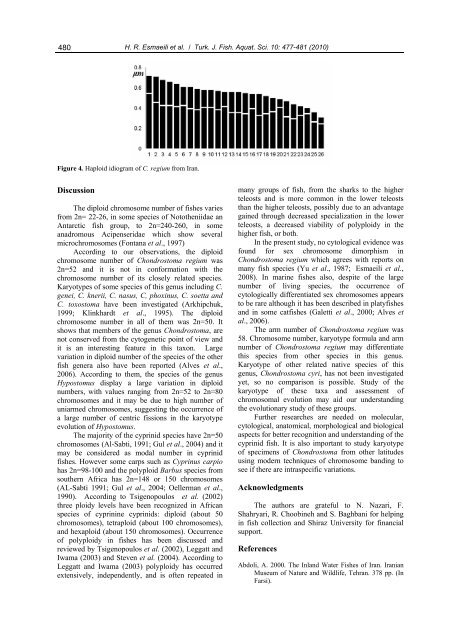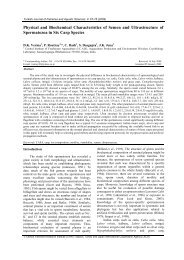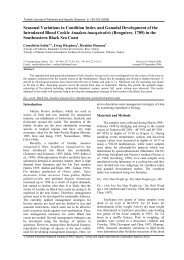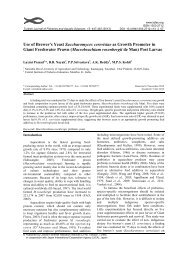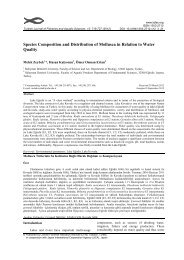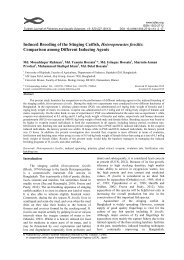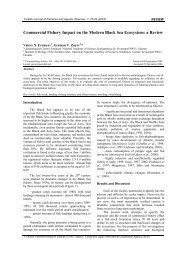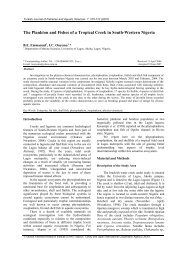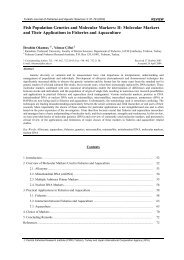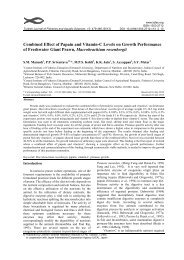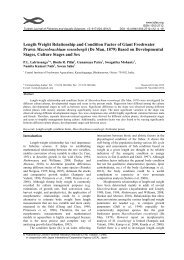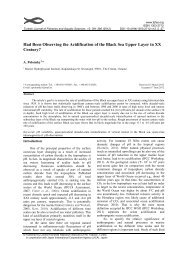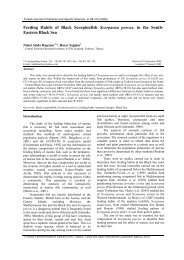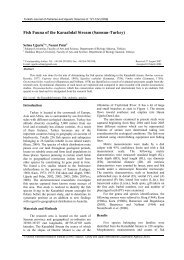Karyotype Analysis of the King Nase Fish, Chondrostoma regium ...
Karyotype Analysis of the King Nase Fish, Chondrostoma regium ...
Karyotype Analysis of the King Nase Fish, Chondrostoma regium ...
You also want an ePaper? Increase the reach of your titles
YUMPU automatically turns print PDFs into web optimized ePapers that Google loves.
480 H. R. Esmaeili et al. / Turk. J. <strong>Fish</strong>. Aquat. Sci. 10: 477-481 (2010)<br />
Figure 4. Haploid idiogram <strong>of</strong> C. <strong>regium</strong> from Iran.<br />
Discussion<br />
The diploid chromosome number <strong>of</strong> fishes varies<br />
from 2n= 22-26, in some species <strong>of</strong> Noto<strong>the</strong>niidae an<br />
Antarctic fish group, to 2n=240-260, in some<br />
anadromous Acipenseridae which show several<br />
microchromosomes (Fontana et al., 1997)<br />
According to our observations, <strong>the</strong> diploid<br />
chromosome number <strong>of</strong> <strong>Chondrostoma</strong> <strong>regium</strong> was<br />
2n=52 and it is not in conformation with <strong>the</strong><br />
chromosome number <strong>of</strong> its closely related species.<br />
<strong>Karyotype</strong>s <strong>of</strong> some species <strong>of</strong> this genus including C.<br />
genei, C. knerii, C. nasus, C, phoxinus, C. soetta and<br />
C. toxostoma have been investigated (Arkhipchuk,<br />
1999; Klinkhardt et al., 1995). The diploid<br />
chromosome number in all <strong>of</strong> <strong>the</strong>m was 2n=50. It<br />
shows that members <strong>of</strong> <strong>the</strong> genus <strong>Chondrostoma</strong>, are<br />
not conserved from <strong>the</strong> cytogenetic point <strong>of</strong> view and<br />
it is an interesting feature in this taxon. Large<br />
variation in diploid number <strong>of</strong> <strong>the</strong> species <strong>of</strong> <strong>the</strong> o<strong>the</strong>r<br />
fish genera also have been reported (Alves et al.,<br />
2006). According to <strong>the</strong>m, <strong>the</strong> species <strong>of</strong> <strong>the</strong> genus<br />
Hypostomus display a large variation in diploid<br />
numbers, with values ranging from 2n=52 to 2n=80<br />
chromosomes and it may be due to high number <strong>of</strong><br />
uniarmed chromosomes, suggesting <strong>the</strong> occurrence <strong>of</strong><br />
a large number <strong>of</strong> centric fissions in <strong>the</strong> karyotype<br />
evolution <strong>of</strong> Hypostomus.<br />
The majority <strong>of</strong> <strong>the</strong> cyprinid species have 2n=50<br />
chromosomes (Al-Sabti, 1991; Gul et al., 2004) and it<br />
may be considered as modal number in cyprinid<br />
fishes. However some carps such as Cyprinus carpio<br />
has 2n=98-100 and <strong>the</strong> polyploid Barbus species from<br />
sou<strong>the</strong>rn Africa has 2n=148 or 150 chromosomes<br />
(AL-Sabti 1991; Gul et al., 2004; Oellerman et al.,<br />
1990). According to Tsigenopoulos et al. (2002)<br />
three ploidy levels have been recognized in African<br />
species <strong>of</strong> cyprinine cyprinids: diploid (about 50<br />
chromosomes), tetraploid (about 100 chromosomes),<br />
and hexaploid (about 150 chromosomes). Occurrence<br />
<strong>of</strong> polyploidy in fishes has been discussed and<br />
reviewed by Tsigenopoulos et al. (2002), Leggatt and<br />
Iwama (2003) and Steven et al. (2004). According to<br />
Leggatt and Iwama (2003) polyploidy has occurred<br />
extensively, independently, and is <strong>of</strong>ten repeated in<br />
many groups <strong>of</strong> fish, from <strong>the</strong> sharks to <strong>the</strong> higher<br />
teleosts and is more common in <strong>the</strong> lower teleosts<br />
than <strong>the</strong> higher teleosts, possibly due to an advantage<br />
gained through decreased specialization in <strong>the</strong> lower<br />
teleosts, a decreased viability <strong>of</strong> polyploidy in <strong>the</strong><br />
higher fish, or both.<br />
In <strong>the</strong> present study, no cytological evidence was<br />
found for sex chromosome dimorphism in<br />
<strong>Chondrostoma</strong> <strong>regium</strong> which agrees with reports on<br />
many fish species (Yu et al., 1987; Esmaeili et al.,<br />
2008). In marine fishes also, despite <strong>of</strong> <strong>the</strong> large<br />
number <strong>of</strong> living species, <strong>the</strong> occurrence <strong>of</strong><br />
cytologically differentiated sex chromosomes appears<br />
to be rare although it has been described in platyfishes<br />
and in some catfishes (Galetti et al., 2000; Alves et<br />
al., 2006).<br />
The arm number <strong>of</strong> <strong>Chondrostoma</strong> <strong>regium</strong> was<br />
58. Chromosome number, karyotype formula and arm<br />
number <strong>of</strong> <strong>Chondrostoma</strong> <strong>regium</strong> may differentiate<br />
this species from o<strong>the</strong>r species in this genus.<br />
<strong>Karyotype</strong> <strong>of</strong> o<strong>the</strong>r related native species <strong>of</strong> this<br />
genus, <strong>Chondrostoma</strong> cyri, has not been investigated<br />
yet, so no comparison is possible. Study <strong>of</strong> <strong>the</strong><br />
karyotype <strong>of</strong> <strong>the</strong>se taxa and assessment <strong>of</strong><br />
chromosomal evolution may aid our understanding<br />
<strong>the</strong> evolutionary study <strong>of</strong> <strong>the</strong>se groups.<br />
Fur<strong>the</strong>r researches are needed on molecular,<br />
cytological, anatomical, morphological and biological<br />
aspects for better recognition and understanding <strong>of</strong> <strong>the</strong><br />
cyprinid fish. It is also important to study karyotype<br />
<strong>of</strong> specimens <strong>of</strong> <strong>Chondrostoma</strong> from o<strong>the</strong>r latitudes<br />
using modern techniques <strong>of</strong> chromosome banding to<br />
see if <strong>the</strong>re are intraspecific variations.<br />
Acknowledgments<br />
The authors are grateful to N. Nazari, F.<br />
Shahryari, R. Choobineh and S. Baghbani for helping<br />
in fish collection and Shiraz University for financial<br />
support.<br />
References<br />
Abdoli, A. 2000. The Inland Water <strong>Fish</strong>es <strong>of</strong> Iran. Iranian<br />
Museum <strong>of</strong> Nature and Wildlife, Tehran. 378 pp. (In<br />
Farsi).


